
This is Tomorrow
Aug-Sept 1956 Whitechapel Gallery, London
In 1952, a group began meeting regularly at the ICA in London, to explore ways in which art and architecture could be better integrated into everyday life, and vice versa. Known as “Independent Group” or ‘IG’, these artists, architects and theorists also wanted to look beyond Modernism, and to incorporate new mass media influences, such as advertising, comic books and science fiction, into art. Their ideas were popularised through exhibitions at the ICA, notably the 1953 Parallel of Life and Art, curated by Nigel Henderson, Eduardo Paolozzi, and Alison and Peter Smithson, and Collages and Life, curated the following year by Lawrence Alloway. Having attended several IG meetings, Theo Crosby, an architect born and trained in South Africa, proposed a more ambitious exhibition that would reflect the ideas of the group. In addition to being an architect—his 1956 house at Rutland Grove, Hammersmith, is seen as an early example of the Brutalist movement—Crosby was also an editor and sculptor, working mainly in plaster and mosaic-style coloured glass. Bryan Robertson, Director of the Whitechapel Art Gallery, agreed to host the exhibition. Titled This is Tomorrow, the concept was loosely based on Groupe Espace, an association in France inspired by the Constructivist movement and André Bloc’s journal Art d’aujourd’hui, formed in 1951. At the Whitechapel, along with Germano Facetti and Edward Wright, Crosby brought together members of IG and other artists and architects. In all, thirty-seven creative talents were assembled into twelve teams, each team being asked to devise an installation in which the boundaries between art and architecture would be blurred. Crosby was in Group One, along with Facetti, Wright, and the sculptor William Turnbull.
This is Tomorrow opened at the Whitechapel on 9th August 1956 and ran for just four weeks. In his catalogue introduction, the art writer Lawrence Alloway cited earlier Modernist movements where collaboration, as with Groupe Espace, was seen as the way forward. However as he observed, ‘yesterday’s tomorrow is not today’ and the art of the latter half of the twentieth century was not to be based on a ‘rosy fiction of the middle ages’. Within the competitive environment of post-war capitalist society, Alloway recognised that the artists at Whitechapel were in competition with each other, each seeking to define what the art of the future might be. The poet David Lewis also contributed an introductory essay. Like Crosby, Lewis had moved to Britain after the introduction of apartheid in South Africa, settling in St. Ives where he married the painter Wilhelmina Barns-Graham. In 1955 Adrian Flowers had photographed Lewis and Barns-Graham in St. Ives. But by the following year, their marriage was breaking up, and Lewis was moving to Leeds to study architecture. He also, like Crosby, was full of enterprise and was promoting a speculative Modernist housing project in Huddersfield.
An innovative work in its own right, the catalogue for This is Tomorrow, designed by Edward Wright and edited by Theo Crosby, documented the teams’ concepts rather than finished results. Each team was asked to submit six pages of material. Richard Hamilton’s collage Just what is it that makes today’s homes so different, so appealing?, created at the home of IG members Magda and Frank Cordell, is probably the contribution best remembered today. Companies, several of whom had sponsored the exhibition, placed advertisements; they included Hille furniture, Wates builders, Crittall windows, ICI Perspex, and plastics firms such as Geon and Styron. Ads were also placed by booksellers and publishers, including Faber and Faber, and Better Books, an alternative bookshop on Charing Cross Road. An artist who worked at Better Books, Anne Buchanan, was also involved in the installation of the exhibition.
On 6th August, three days before the opening, Adrian Flowers visited the Whitechapel and photographed the installations nearing completion. [AF Archive Job No. 2086]. He was likely there at the invitation of artist Victor Pasmore—at that time Pasmore’s son John was working as an assistant in the Flowers’ studio. Notwithstanding this link, since his own school days at Sherborne, Flowers had been fascinated with advertising imagery in magazines such as Life, and would have delighted in artists Richard Hamilton and John McHale using mass media images in their artworks. Although it would be fifteen years before Angela Flowers opened her own art gallery, she was also with Adrian Flowers at the Whitechapel that day, along with their young son Adam.
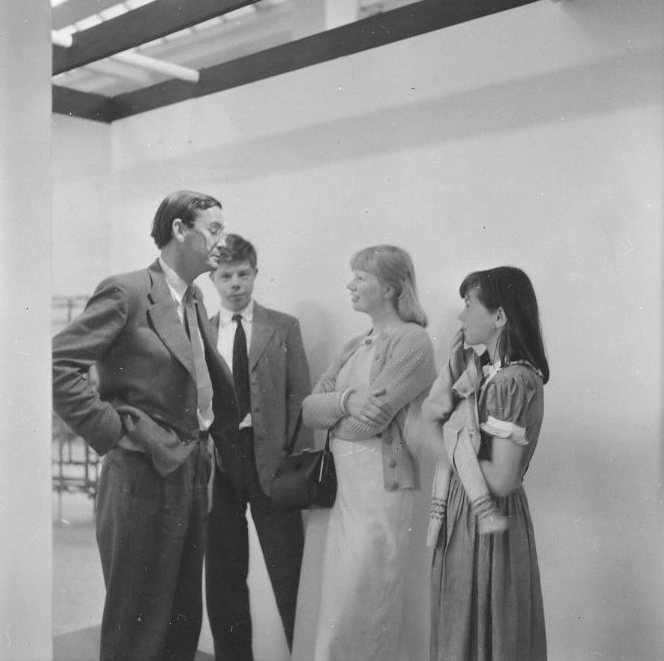
David Lewis on the left.
Photograph: Adrian Flowers
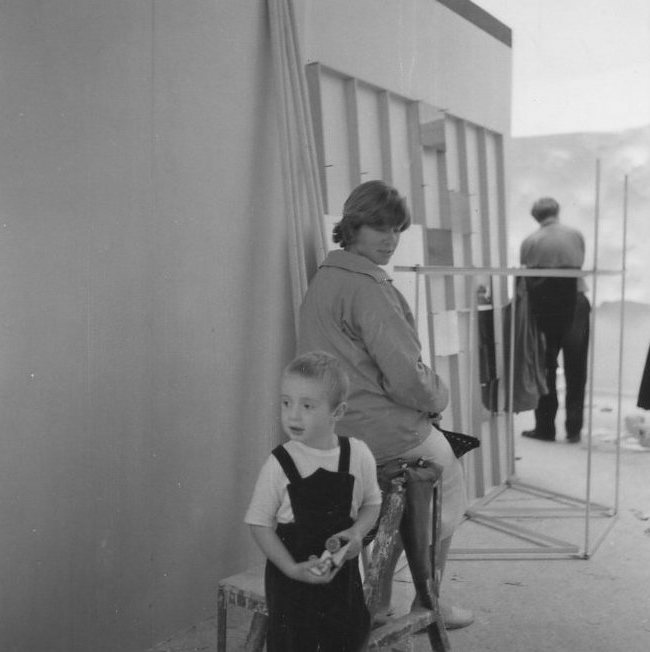
Angela Flowers sitting behind.
Photograph: Adrian Flowers
The sixty photographs taken by Adrian Flowers are for the most part general shots, showing the large gallery spaces being taken over by temporary walls, pavilions, sculptures and paintings. Many images feature Pasmore, but Adrian also documented other areas, including Group 2’s Fun House, one of the more crowd-friendly installations in the exhibition. Fun House was devised by Richard Hamilton, John McHale and architect John Voelcker, the latter creating the frame structure within which artifacts and artworks were displayed. Flowers also photographed the large Op-Art murals, designed by McHale and painted by Magda Cordell. A founder of the ICA, and an originator of the Pop Art movement in Britain, McHale had just returned from a year at the Albers Foundation in the United States. His sketch for a poster with three bold arrows, translated into a screen-print design by Richard Hamilton, conveys the sense of direct, graphic excitement that characterised This is Tomorrow. Adrian also photographed the Op-Art discs, published by Marcel Duchamp as lithographs two decades earlier, and intended for display on record turntables. Reissued in a new edition in 1953 by Enrico Donati, McHale had acquired a set of these Rotoreliefs in New York directly from Duchamp. Several appear in Flowers’ photographs of the Group 2 installation, including Rotorelief No. 12 – Spirale Blanche.
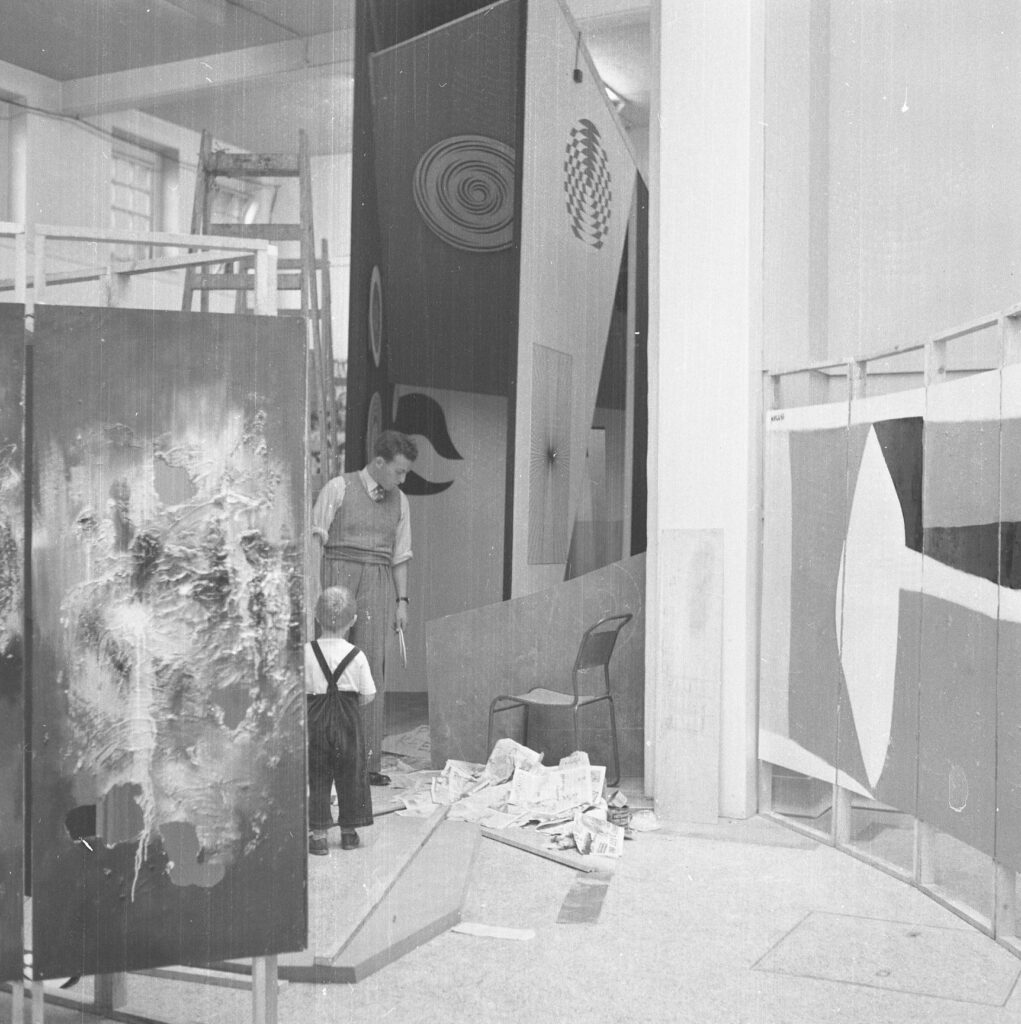

Group 3 comprised three artists represented by the Gimpel Fils Gallery; the abstract painter and furniture designer Jon Catleugh; James Hull, an industrial designer who had worked on murals for the Festival of Britain; and Leslie Thornton, a sculptor from Yorkshire., whose skeletal metal sculptures stood tall in the exhibition spaces. The Group 3 manifesto playfully recorded their love of organised chaos, Eartha Kitt and American cars; and their dislike of dove grey, phone bills and the church. Anthony Jackson and Emilio Scanavino were in Group Four, along with Sarah Jackson, an American-born sculptor whose white abstract plaster sculptures with their writhing forms animated the Whitechapel space. Several Expressionist paintings by Scanavino were suspended from the ceilings.
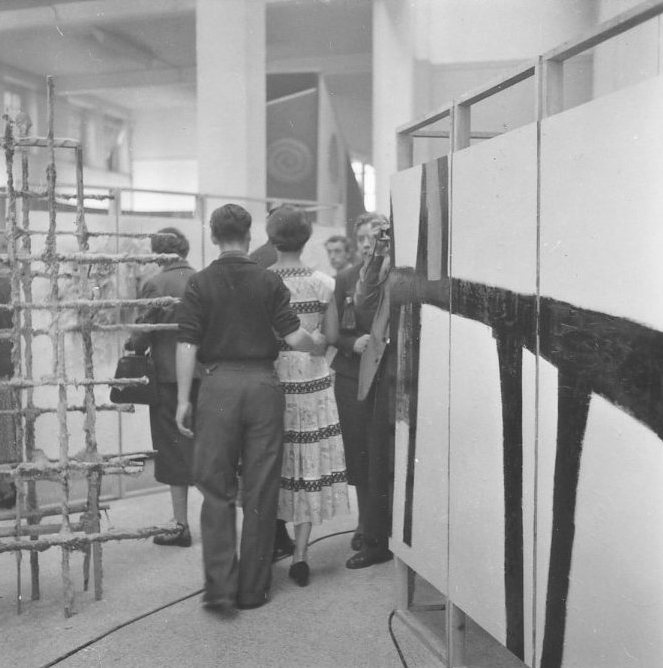
Leslie Thornton.
Photographs: Adrian Flowers

Group Five comprised Anthony Hill, Denis Williams and John Ernest; Ernest’s tall Constructivist sculptures, constructed of vertical steel rods and horizontal Perspex panels, were being assembled as Flowers took his photos.
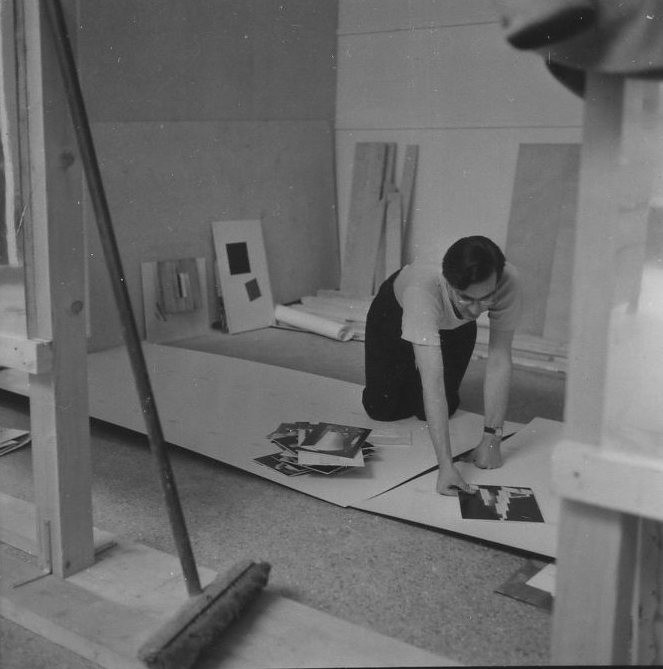
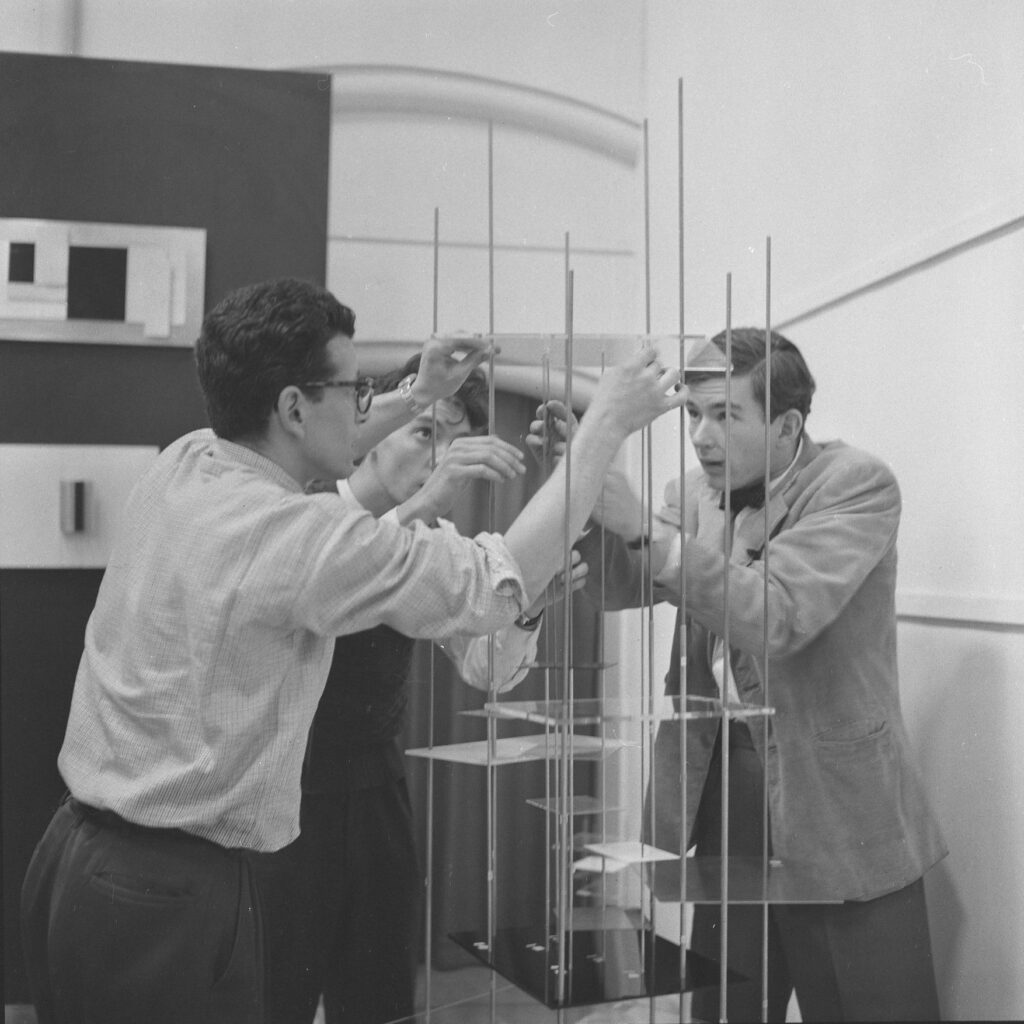
Photographs: Adrian Flowers

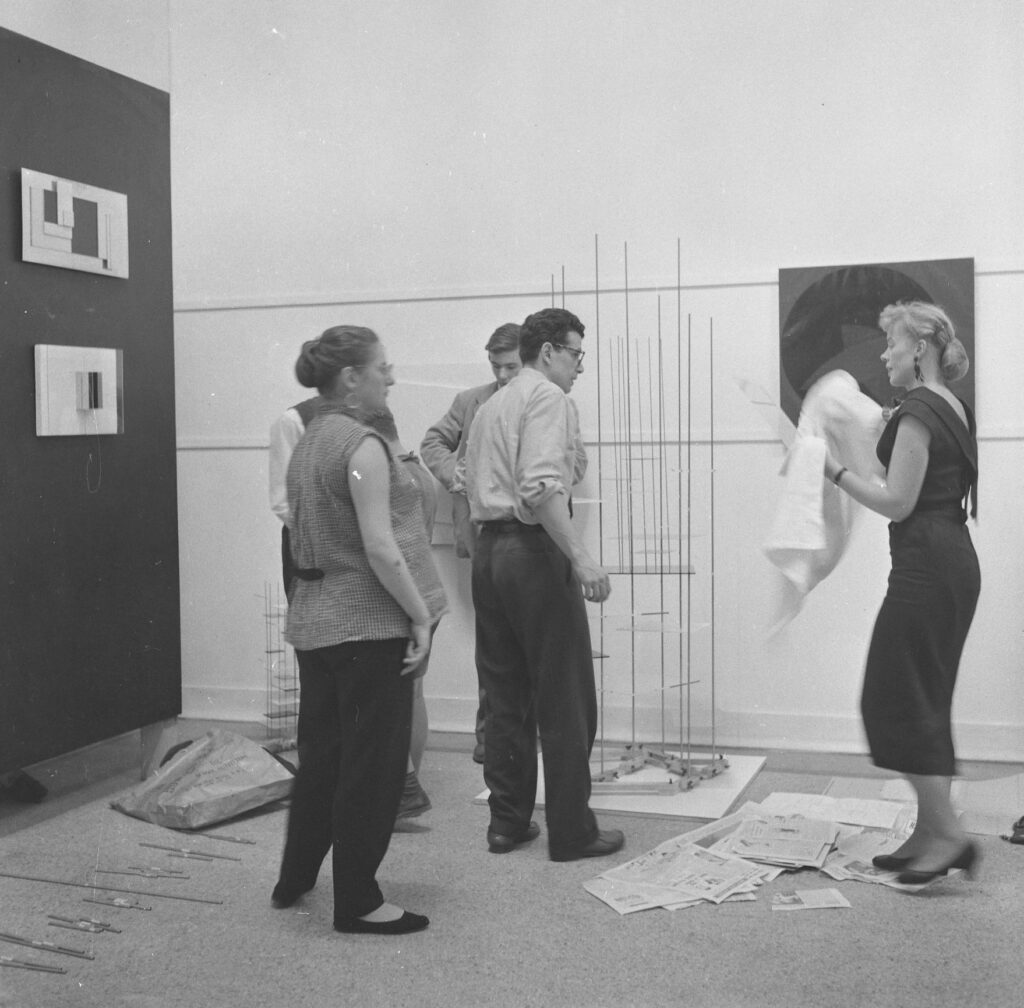
Photographs: Adrian Flowers
The Group 6 installation, sub-titled “Patio and Pavilion” was the work of IG members Peter and Alison Smithson, Eduardo Paolozzi and Nigel Henderson. In the Group 7 installation, free-standing walls, designed by Ernö Goldfinger, were used to display works by Victor Pasmore and Helen Phillips. A drawing by Goldfinger was reproduced in the catalogue, and he also appears in Flowers’ photographs, standing beside Pasmore. Goldfinger’s daughter Liz later worked for Crosby at the magazine AD.
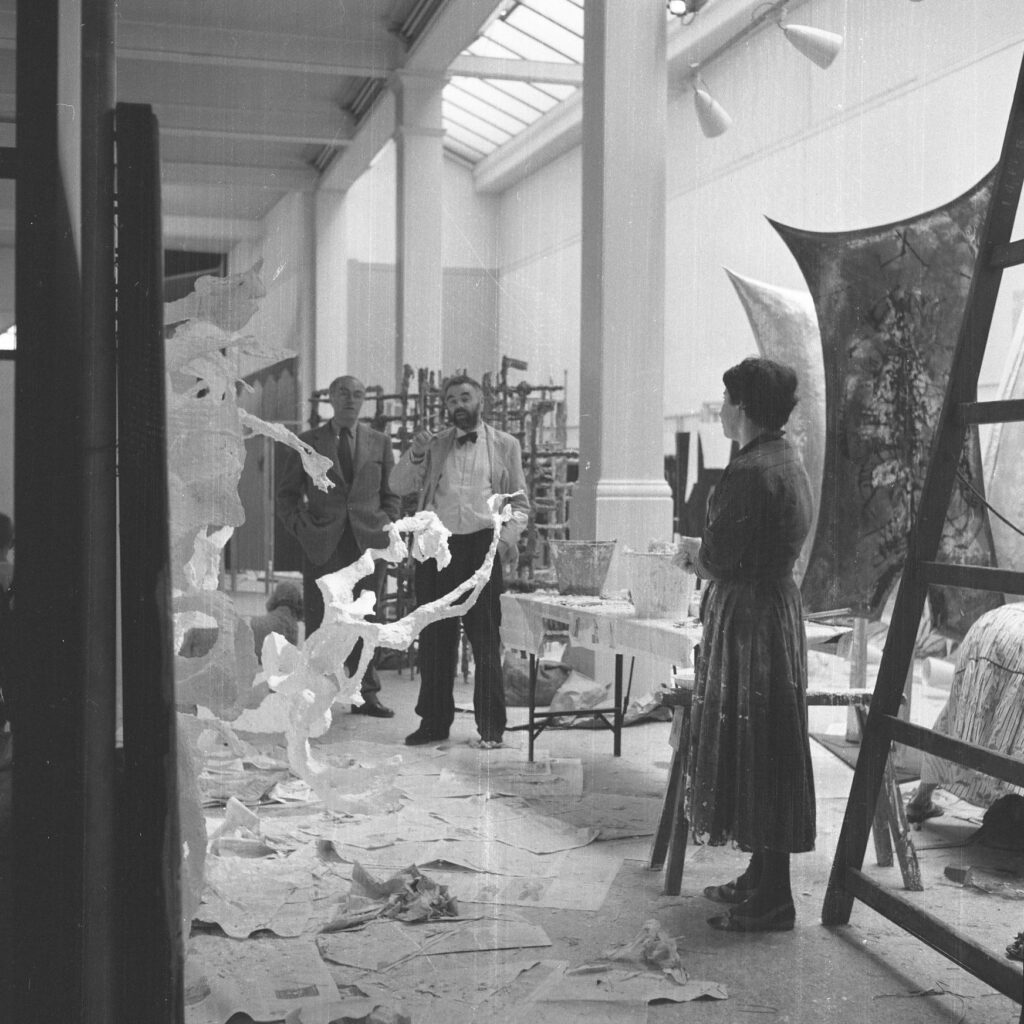
Photograph: Adrian Flowers
One photograph by Flowers was taken looking through the Group 7 installation into the Group 8 section, that included Richard Matthews, architect/sculptor Michael Pine, and James Stirling. Born in Wolverhampton in 1928, Pine had studied architecture in Birmingham and lived in St. Ives, Cornwall. His organic papier-mache “bubble” sculptures feature in several photographs. In Group 9 were Kenneth and Mary Martin, and John Weeks—the latter taking the diffusing of boundaries idea literally, as he appears also in Group 11. To display the work of the Martins, Weeks designed a modular stand made of free-standing gypsum plaster “Bellrock” panels, arranged in a triangular plan and fastened together at the top, so as to be self-supporting.
One of the most striking photographs by Flowers is of quirky Modernist corridor in the Group Ten installation. The design of this corridor was the work of Frank Newby, an engineer who worked on the Skylon at the 1951 Festival of Britain, and architects Colin St. John Wilson and Peter Carter, both of whom worked on post-war housing in London. St. John Wilson appears in one photograph, kneeling as he works on the corridor. Visible in the distance is ‘Robbie the Robot’, a figure from Forbidden Planet, a science-fiction film released earlier that year. The official opening of the exhibition was performed by Robbie.
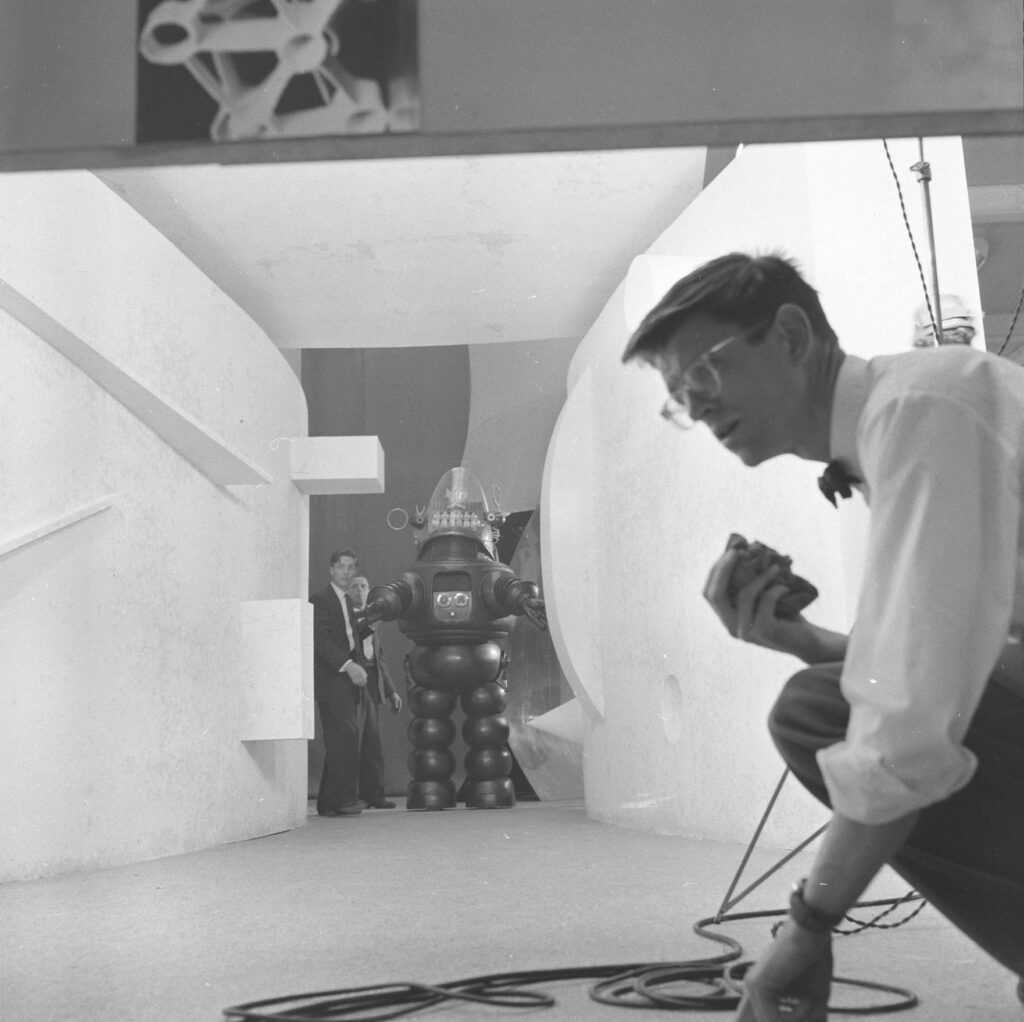
Photograph: Adrian Flowers
Group Ten also included work by Robert Adams, a sculptor from Northampton, who features elsewhere in the AF Archive—indeed several of the participants in This is Tomorrowappear elsewhere in the Archive, including Pasmore, John Ernest, Anthony Hill, Kenneth and Mary Martin, and Robert Adams.
Group Eleven comprised Adrian Heath, a sculptor who had studied at the Slade, and John Weeks, a graduate of the Architectural Association. Two years earlier, Weeks had organised an exhibition at the Building Centre entitled Artist Versus Machine. Together, Heath and Weeks designed a free-standing wall that was built inside the Whitechapel Gallery. Made of standard concrete blocks laid without mortar, it served both as an architectural statement and a Minimalist sculpture. Heath also showed abstract geometric paintings, composed of rectangles and squares. The catalogue pages for Group 12—Geoffrey Holroyd, Toni Del Renzio and Lawrence Alloway—illustrated with Venn diagrams, summed up the themes of This is Tomorrow, and reiterated the idea of promoting collaboration between artist and architect.
Heavily marketed, featured by Pathé News in cinemas, and with high attendances, This is Tomorrow was a brief and vivid snapshot in time. However the IG group did not survive long; later that year, Crosby set up his own architect’s office, while Peter Carter left to work with Eero Saarinen in the United States; John McHale also moved to the US, and Michael Pine to Canada. David Lewis settled in Pittsburgh, where he was appointed Professor at Carnegie Mellon University. Lawrence Alloway worked as a curator at the Guggenheim in New York, before following McHale to Southern Illinois University, and afterwards taught at SUNY in Stony Brook. Reyner Banham, who contributed an introductory text to the This is Tomorrow catalogue, also moved to the United States, publishing influential books on architecture and urban design, notably his 1971 Los Angeles; The Architecture of Four Ecologies. The term ‘brain drain’ was coined in these years, to describe the migration of talent to North America. Some participants in the exhibition, such as James Stirling and Eduardo Paolozzi, went on to international fame, while others, like John Voelcker, enjoyed intermittent success. In 1958, Voelcker designed a Modernist house near Barnet for jazz musician Humphrey Lyttleton, that featured a Surrealist mural by McHale. Anne Buchanan and Theo Crosby raised a family in Hammersmith, while their friends Peter and Alison Smithson designed controversial Brutalist housing projects. A decade after This is Tomorrow, Adrian Heath played a key role in encouraging Angela Flowers to set up her first gallery. It opened in February 1970, in Lisle Street, on the floor above the headquarters of the Artists Association, of which Heath was chairman. Coincidentally, the following year, an exhibition of Anne Buchanan Crosby’s psycho-mythological paintings took place at the AIA Gallery. In retrospect, the Minimalist abstract artists at the Whitechapel—many of whom feature separately in the Adrian Flowers Archive—remained true to their aesthetic vision, while the artists and architects interested in mass-media enjoyed mixed fortunes in the decades that followed, with many pursuing careers in academic institutions in America.
Text: Peter Murray
Editor: Francesca Flowers
All images subject to copyright.
Adrian Flowers Archive ©